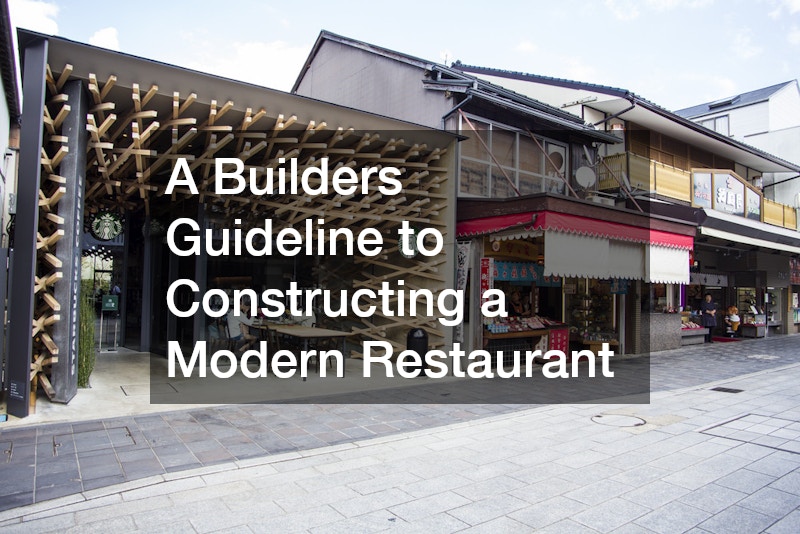Constructing a modern restaurant is a multifaceted endeavor that demands a deep understanding of various aspects, from initial planning to final execution. The complexity of the construction process necessitates careful consideration of numerous factors, including client vision, site selection, design, and compliance with safety regulations. Builders must ensure that every element—from the selection of contractors to the integration of heating and cooling systems—is meticulously planned and executed. The final result should be a restaurant that not only meets contemporary standards but also enhances operational efficiency and customer experience.
In this guide, we will explore the critical considerations builders must address when constructing a modern restaurant. Each section will delve into essential topics, from initial planning steps to ensuring a seamless opening, providing a comprehensive overview of the necessary components to create a successful dining establishment.
1. What are the Initial Planning Steps?
1.1 Understanding the Client’s Vision
The foundation of any successful restaurant build begins with a clear understanding of the client’s vision. This includes the type of cuisine, target audience, and desired ambiance. Builders should engage in extensive discussions with the client to ensure alignment on all aspects, from the size of the kitchen to the aesthetic elements that will define the space.
1.2 Site Assessment and Feasibility Study
Once the vision is established, the next step is conducting a site assessment and feasibility study. This involves evaluating the chosen location for accessibility, zoning regulations, and potential challenges related to construction. Builders often collaborate with local septic companies to ensure that waste management systems are appropriately integrated, especially in areas lacking municipal services.
1.3 Budgeting and Financing
After assessing the site, builders must assist clients in developing a comprehensive budget. This budget should encompass all construction costs, including materials, labor, and potential crane service for lifting heavy structures. It’s also wise to include contingency funds for unexpected expenses, such as additional heating oil for maintaining temperature during construction.
2. How to Choose the Right Location?
2.1 Demographic Analysis
Selecting the right location is crucial for a restaurant’s success. Builders should conduct a demographic analysis to identify the target market’s characteristics, such as age, income level, and dining preferences. Understanding these factors can guide the overall design and operational strategy of the restaurant.
2.2 Accessibility and Visibility
Accessibility and visibility are key elements in choosing a location. The site should be easily accessible by foot and vehicle, with ample parking options. High visibility can significantly impact foot traffic, making it an essential consideration. Builders may need to collaborate with contractors specializing in asphalt paving to ensure that the parking lot and surrounding roads are in excellent condition.
2.3 Competitor Analysis
Conducting a competitor analysis is also vital. Builders should examine nearby dining establishments to identify gaps in the market. Understanding what competitors offer can help the client position their restaurant uniquely, ensuring that it stands out in a crowded marketplace.

3. What are the Essential Design Considerations?
3.1 Layout and Space Optimization
The layout of a restaurant is critical for operational efficiency. Builders must work with designers to create a space that optimizes workflow, from the kitchen to the dining area. This may involve strategically placing equipment and designing service areas to minimize wait times and enhance customer experience.
3.2 Aesthetic Appeal and Branding
Aesthetics play a vital role in attracting customers. The design should reflect the restaurant’s brand identity, using materials and colors that align with the overall concept. This could include elements such as retractable screens to create an inviting outdoor dining area or unique masonry work that adds character to the building.
3.3 Compliance with Building Codes
Compliance with local building codes and health regulations is non-negotiable. Builders must ensure that the design adheres to all safety standards, including fire codes and food safety regulations. This might involve consulting with specialized contractors to navigate complex requirements.
4. How to Effectively Manage Construction Teams?
4.1 Selecting Skilled Contractors
Selecting the right contractors is essential for successful construction. Builders should prioritize contractors with experience in restaurant construction and a proven track record. This includes masonry companies for structural elements and HVAC specialists for heating and cooling systems.
4.2 Communication and Coordination
Effective communication and coordination among team members can significantly impact project timelines. Regular meetings and updates can help ensure that everyone is aligned and aware of any changes or challenges that arise during construction.
4.3 Conflict Resolution
Conflict is an inevitable part of any construction project. Builders must be prepared to address disputes swiftly to avoid delays. This may involve mediation between contractors or negotiating solutions to unforeseen issues, such as problems with a dumpster rental during site cleanup.
5. What Materials are Suitable for Different Sections?
5.1 Durable Flooring Options
Choosing the right flooring material is crucial in a restaurant environment. Builders should consider durable options that can withstand heavy foot traffic and spills. Materials like porcelain tiles or polished concrete are often excellent choices for high-traffic areas.
5.2 Heat and Moisture Resistant Materials
In areas such as kitchens and bathrooms, builders must prioritize heat and moisture-resistant materials. Using appropriate materials can prevent mold growth and prolong the lifespan of installations. This may include waterproofing measures and selecting suitable finishes for surfaces exposed to heat and moisture.
5.3 Sustainable and Eco-friendly Choices
As sustainability becomes increasingly important, builders should explore eco-friendly materials. Options like reclaimed wood or recycled tiles can reduce the environmental impact of the restaurant’s construction. Additionally, using propane for kitchen appliances can be more sustainable than traditional heating oil.

6. How to Integrate Modern Technology?
6.1 Smart Kitchen Appliances
Integrating modern technology can significantly enhance restaurant operations. Builders should consider incorporating smart kitchen appliances that improve efficiency and reduce energy consumption. For example, ovens that can be programmed remotely or refrigerators that monitor temperature and energy use.
6.2 Energy Management Systems
Energy management systems can help monitor and optimize energy use throughout the restaurant. These systems allow for the efficient operation of heating and cooling systems, ensuring comfort for both staff and customers while minimizing operational costs.
6.3 Customer Interaction Technologies
Modern restaurants often benefit from technology that enhances customer interaction. Builders should consider implementing systems for online reservations, digital menus, and contactless payment options. These technologies can streamline operations and improve the overall dining experience.
7. What are the Key Safety and Health Regulations?
7.1 Fire Safety Protocols
Fire safety is a paramount concern in restaurant construction. Builders must ensure that the design incorporates fire safety protocols, including proper exits, fire extinguishers, and fire-resistant materials. Compliance with local fire codes is essential for the safety of both employees and customers.
7.2 Food Safety Standards
Compliance with food safety standards is crucial. This involves designing kitchens that meet health regulations, including proper ventilation, sanitation areas, and safe food storage practices. Builders should work closely with health inspectors to ensure all requirements are met.
7.3 Workplace Safety Guidelines
Workplace safety is another critical area of focus. Builders must adhere to workplace safety guidelines throughout the construction process, ensuring that all contractors follow appropriate safety measures to protect their workers from hazards on site.
8. How to Plan for Sustainable Operations?
8.1 Energy Efficient Design
Designing for energy efficiency can significantly reduce operational costs in the long run. Builders should consider using insulation that meets or exceeds standards, energy-efficient windows, and strategically placed skylights to maximize natural light.
8.2 Waste Management Systems
Implementing effective waste management systems is vital for modern restaurants. Builders should work with local dumpster rental services to establish a plan for regular waste disposal. This includes recycling and composting options to minimize environmental impact.
8.3 Water Conservation Techniques
Water conservation techniques should also be integrated into the design. Builders can install low-flow fixtures and implement greywater systems to reduce water usage without compromising customer experience or operational efficiency.

9. What are the Best Practices for Interior Fit-outs?
9.1 Choosing Comfortable Seating
Comfortable seating is essential for customer satisfaction. Builders should work with designers to select furniture that not only complements the restaurant’s aesthetic but also provides comfort for diners during their meals.
9.2 Lighting Design for Ambience
Lighting design can dramatically affect a restaurant’s atmosphere. Builders should consider various lighting options, from ambient to task lighting, to create a warm and inviting environment. Dimmer switches can also allow for flexibility in setting the mood during different times of the day.
9.3 Acoustic Treatments
Acoustic treatments are often overlooked but are crucial for a pleasant dining experience. Builders should consider installing sound-absorbing materials to minimize noise levels, ensuring that conversations can be held without excessive disruption.
10. How to Ensure a Seamless Opening?
10.1 Final Inspections and Approvals
Before opening, thorough final inspections and approvals are necessary to ensure compliance with all local regulations and codes. Builders must coordinate with health and safety inspectors to confirm that the restaurant is ready for operation.
10.2 Staff Training and Simulations
Training staff is vital for a successful launch. Builders can help create an environment conducive to staff training, ensuring that all employees are well-versed in safety protocols, operational procedures, and customer service expectations.
10.3 Marketing and Launch Strategies
Finally, builders should assist clients in developing effective marketing and launch strategies. This includes planning a grand opening event that attracts potential customers and establishes the restaurant’s presence in the community.
11. How to Incorporate Outdoor Spaces?
11.1 Designing Outdoor Dining Areas
Incorporating outdoor dining spaces can enhance a restaurant’s appeal, especially in favorable climates. Builders should consider how to design these areas for comfort and aesthetics. Features such as retractable screens can help create a flexible environment that protects diners from the elements while providing an open-air feel when desired. Landscaping should also be planned carefully to complement the restaurant’s theme and create an inviting atmosphere.
11.2 Managing Utility Installations
Building outdoor spaces often requires careful planning around utility installations. This includes ensuring proper access to water for landscaping and outdoor kitchens, as well as electrical wiring for lighting and heating. Builders should collaborate with HVAC contractors to implement effective heating and cooling solutions for outdoor dining areas, allowing for year-round use.
11.3 Safety Considerations
Safety is paramount in outdoor spaces, particularly when considering the potential hazards of inclement weather. Builders should ensure that the materials used are slip-resistant and that any structures, such as awnings or patios, are securely anchored. Additionally, appropriate lighting must be installed to ensure that diners can navigate safely during evening hours.

12. How to Address Environmental Impact?
12.1 Eco-Friendly Construction Practices
Adopting eco-friendly construction practices can significantly reduce a restaurant’s environmental impact. Builders should prioritize using sustainable materials and reducing waste throughout the construction process. This might involve partnering with masonry companies that specialize in eco-friendly products or sourcing reclaimed materials for aesthetic features.
12.2 Energy-Efficient Systems
Implementing energy-efficient systems is essential for modern restaurants aiming to minimize their carbon footprint. This includes installing energy-efficient heating and cooling systems, as well as appliances that use less propane or heating oil. Builders should also consider using renewable energy sources, such as solar panels, to power the restaurant.
12.3 Water Management Strategies
Effective water management strategies can further enhance a restaurant’s sustainability efforts. Builders should explore options such as rainwater harvesting systems or greywater recycling to reduce overall water usage. Additionally, installing low-flow fixtures can help conserve water without sacrificing performance in kitchens and restrooms.
13. How to Plan for Future Expansion?
13.1 Flexibility in Design
Planning for potential future expansion is a wise strategy for restaurant builders. Designing the restaurant layout with flexibility in mind can facilitate easier modifications later on. This might include leaving space for additional dining areas or the ability to expand the kitchen without extensive renovations.
13.2 Modular Construction Techniques
Builders may also consider modular construction techniques, which allow for quicker adjustments and expansions. This method involves prefabricating sections of the restaurant off-site, enabling faster on-site assembly. This approach can significantly reduce disruption during the expansion process and minimize construction waste.
13.3 Strategic Partnerships
Establishing strategic partnerships with local businesses and contractors can aid in future expansions. Builders should create connections with local suppliers for materials, such as flooring or masonry, ensuring that any future construction remains consistent with the original design. Additionally, fostering relationships with local septic companies can help streamline any needed adjustments to waste management systems as the restaurant grows.
Conclusion
Constructing a modern restaurant requires careful planning, skilled execution, and adherence to contemporary standards. By following a comprehensive builder’s guideline, builders can navigate the complexities of the construction process while ensuring that every aspect—from site selection to final fit-out—is meticulously addressed. The result is a restaurant that not only meets the client’s vision but also operates efficiently, sustainably, and successfully in a competitive landscape. With thorough planning and execution, builders can create a vibrant dining establishment that enhances the culinary scene and delights customers for years to come.
